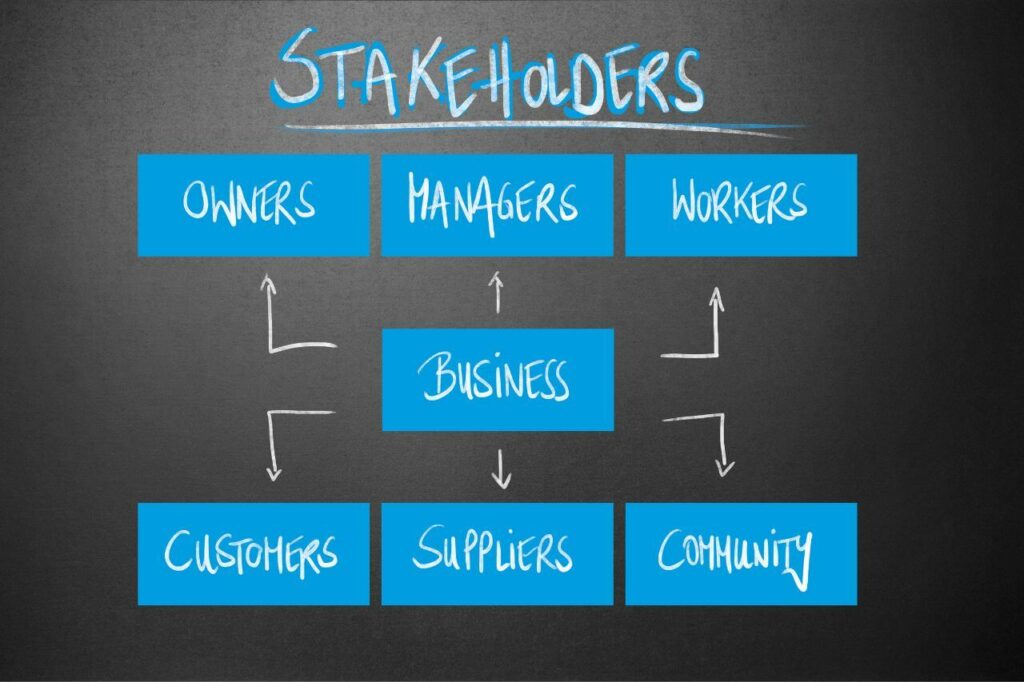As a project manager, it is estimated that up to 80% of your time is spent on communicating with your project team and stakeholders.
Projects don’t exist in isolation and are subject to internal and external forces. These forces happen to be a factor of the project stakeholders.
For your project to be a success, your ability to manage stakeholder engagement effectively is a crucial component.
Whether it’s a small team or a large organization you’re leading, you have to effectively manage the relationships and expectations of all stakeholders to ensure the smooth and successful execution of your project.
Managing stakeholder engagement is a core part of the overall stakeholder management PMP knowledge area.
This article will provide a step-by-step guide on how to manage stakeholder engagement like a pro from identifying your stakeholders to maintaining ongoing communication.
Who is a Project Stakeholder?
In project management, a stakeholder is an individual or group that has an interest in or impact on a project.
This can include project team members, clients, customers, suppliers, shareholders, and other groups that are affected by the project or have the ability to influence its outcome.
It’s essential to identify all relevant stakeholders early in the project planning process to effectively manage their expectations and ensure their needs are considered throughout the project.
There are different types of stakeholders, including primary stakeholders (those who will directly benefit or be affected by the project), secondary stakeholders (those who may be indirectly impacted by the project), and tertiary stakeholders (those who have a more peripheral interest in the project).
Understanding the needs and expectations of each stakeholder group is crucial for project success, as it helps you as a project manager to make informed decisions and build strong relationships with all relevant parties.

Project Stakeholder Management
Stakeholder management refers to the process of effectively engaging with and managing the expectations of individuals or groups that have an interest in or impact on a project.
This includes identifying all relevant stakeholders, analyzing their level of interest and influence, developing a plan for communication and engagement, and maintaining ongoing communication throughout the project.
The goal of stakeholder management is to ensure that the needs and expectations of all relevant parties are considered and addressed, which can help to ensure the success of the project.
Effective stakeholder management involves regular communication, transparency, and the ability to adapt to changing needs and expectations.
By taking the time to understand and manage the expectations of stakeholders, you can build trust, improve decision-making, and increase the chances of project success.
Project Stakeholder Management Processes
Stakeholder management processes refer to the steps and strategies used to effectively engage with and manage the expectations of individuals or groups that have an interest in or impact on a project.
These processes are designed to ensure that the needs and expectations of all relevant stakeholders are considered and addressed.
According to the Project Management Book of Knowledge (PMBOK), stakeholder management is a project management knowledge area that consists of 4 processes. These processes include the following:
1. Identify stakeholders
2. Plan stakeholder engagement
3. Manage stakeholder engagement
4. Monitor stakeholder engagement
Identify Stakeholders Process
Before you can manage anything, you have to first identify and measure it. This is the same when it comes to managing stakeholders for your project.
The process of identifying stakeholders involves making a list of all the individuals or groups that will be impacted by a project or who have the ability to influence its outcome.
This is an important step in the stakeholder management process, as it helps you to understand the needs and expectations of all relevant parties and ensure that they are considered throughout the project.
There are several steps involved in the process of identifying stakeholders:
1. Define the scope of the project: Clearly define the goals and objectives of the project and how it will impact different individuals or groups.
2. Make a list of potential stakeholders: Identify all the individuals or groups that may be affected by the project or who have an interest in its success or failure.
This may include project team members, clients, customers, suppliers, shareholders, and others.
3. Assess the level of interest and influence of each stakeholder: Determine the level of impact that each stakeholder has on the project and their level of interest in its outcome.
This will help you prioritize your engagement efforts. One tool for this is the power interest grid.
4. Confirm the list of stakeholders: Verify the list of stakeholders with project team members and other relevant parties to ensure that all relevant stakeholders have been identified.
By following these steps, you can effectively identify all relevant stakeholders and begin the process of managing their expectations and needs.

Plan Stakeholder Engagement Process
When you have successfully identified your project stakeholders and analyzed their impact and interests, the next step is to plan how to engage with them.
The process of planning stakeholder management involves creating a strategy for how you will engage and communicate with stakeholders throughout a project.
This plan should outline specific strategies for reaching out to stakeholders, as well as a timeline for when and how often you will communicate with them.
The goal of stakeholder management planning is to ensure that the needs and expectations of all relevant stakeholders are considered and addressed throughout the project.
To plan stakeholder management, follow these steps:
1. Determine stakeholder needs and expectations: Analyze the needs, concerns, and expectations of each stakeholder group.
This can be done through direct communication, such as meetings or surveys, or by analyzing existing documents and data.
2. Develop a communication plan: Based on the information gathered in step 1, create a plan for how you will communicate with stakeholders throughout the project.
This may include regular meetings, updates, or targeted communication for specific groups.
By following these steps and creating a comprehensive stakeholder management plan, you can ensure that the needs and expectations of all relevant stakeholders are effectively managed throughout the project.

Manage Stakeholder Engagement Process
The process of managing stakeholder engagement involves effectively communicating with and managing the expectations of individuals or groups that have an interest in or impact on a project according to the project stakeholder engagement plan.
This process is designed to ensure that the needs and expectations of all relevant stakeholders are considered and addressed throughout the project.
To manage stakeholder engagement, follow these steps:
1. Implement and monitor the stakeholder engagement plan: Put the stakeholder engagement plan, which was developed in the planning stage, into action and regularly check in to ensure that it is effective.
Be open to feedback and adjust your approach as needed.
Maintain ongoing communication: Stakeholder engagement doesn’t end when the project does. Continue to communicate with stakeholders and address any post-project impacts or concerns.
By following these steps and maintaining ongoing communication, you can effectively manage stakeholder engagement and set your project up for success.

Monitor Stakeholder Engagement Process
The process of monitoring stakeholder engagement involves regularly checking in on the effectiveness of your stakeholder engagement plan and making adjustments as needed.
This is an ongoing process that should be performed throughout the project in order to ensure that the needs and expectations of all relevant stakeholders are being met.
To monitor stakeholder engagement, follow these steps:
1. Track stakeholder engagement and participation: Collect and analyze data on the level of engagement and participation of each stakeholder group.
This can be done through meetings, surveys, or other forms of communication.
2. Identify areas for improvement: Based on the data collected in step 1, identify any areas where stakeholder engagement could be improved or where stakeholder needs are not being met.
3. Adjust the stakeholder engagement plan: Make changes to the stakeholder engagement plan as needed in order to address any identified areas for improvement.
4. Continue to monitor and adjust as needed: Repeat the process of tracking stakeholder engagement and identifying areas for improvement on a regular basis in order to ensure that the needs and expectations of all stakeholders are being effectively managed.
By regularly monitoring stakeholder engagement and making necessary adjustments, you can ensure that your stakeholder management efforts are targeted and effective.

Strategies for Effective Stakeholder Engagement
Effective stakeholder engagement involves developing strategies for communicating with and managing the expectations of individuals or groups that have an interest in or impact on a project.
By following these strategies, you can build trust, improve decision-making, and increase the chances of project success.
Some strategies for effective stakeholder engagement include:
1. Identify the most appropriate communication channels: Determine the best methods for reaching out to each stakeholder group based on their preferences and needs.
This may include in-person meetings, phone calls, emails, or social media.
2. Develop targeted communication plans: Create customized communication plans for each stakeholder group that consider their specific needs and expectations.
3. Foster two-way communication: Encourage stakeholders to provide feedback and engage in open dialogue about the project.
4. Be responsive to stakeholder needs: Be willing to adapt your approach as needed in order to meet the changing needs and expectations of stakeholders.
5. Monitor and evaluate stakeholder engagement: Regularly track the level of engagement and participation of each stakeholder group and identify areas for improvement.
By following these strategies, you can effectively manage stakeholder expectations and ensure the success of your projects.
Conclusion
As earlier iterated, you will spend the bulk of your time when managing a project on communication. From the project initiation to planning, executing, monitoring and controlling, to closing.
This communication happens to be with people who are relevant to the project and they’re the stakeholders.
To manage the project successfully, you need to be able to plan and manage stakeholder engagement properly.
By following this article as a guide, you should be able to manage stakeholder engagement for your projects and deliver the expected value.





